If you are looking for the best wood burning stoves, our reviews will help you select the best fit for your home. A wood burning stove will be a great focal point of your living room, creating a warm and cozy feeling that makes the room look complete. Wood burning stoves can also offer a practical way of cutting energy costs. Whatever the reason for getting a wood stove, our wood stove reviews and product guides will help you get the best stove, ranging from budget models to impressively large soapstone, cast iron and steel stoves. We focus on renowned brands that produce incredible wood burning stoves with a mix of beauty, longevity and efficiency.
Check Out The Best Wood Burninig Stoves Reviewed By Our Experts
| Name | Rating | Statistics | Link | |
|---|---|---|---|---|
| 1 |
Pleasant Hearth 2,200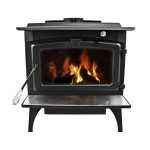
|
Read review |
Features
Design
Efficiency
Durability
Value for money
|
Check Availability |
| 2 |
US Stove 2000 EPA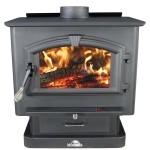
|
Read review |
Features
Design
Efficiency
Durability
Value for money
|
Check Availability |
| 3 |
Napoleon EPA Independence
|
Read review |
Features
Design
Efficiency
Durability
Value for money
|
Check Availability |
| 4 |
Vogelzang TR001 Defender EPA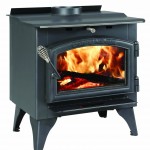
|
Read review |
Features
Design
Efficiency
Durability
Value for money
|
Check Availability |
| 5 |
Drolet HT2000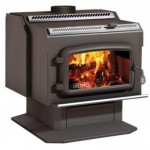
|
Read review |
Features
Design
Efficiency
Durability
Value for money
|
Check Availability |
Buying Guide And Recommended Wood Burning Stoves
Are you still thinking about if a wood burning stove is the right product for your home? We provide you with valuable information about wood stoves and what to consider when finding the right one for your home.
Contents
What Makes Wood Burning Stoves Perfect For Your Home?
Wood burning stoves are arguably the most reliable stoves you can have for your home. These stoves trace their origin from Norway. There, they were used in cottages and cabins. Today, these stoves are now finding their way into modern homes. Wood stoves come in different sizes, shapes and colors. Normally, they measure 12 inches wide and 19 inches deep. This is the average size that makes them a perfect fit for small, mid-sized and even large homes. The size also makes it possible to use different types of fuel. Not only can the stoves devour anything from wood logs to sawdust, old pallets, wood chips and scrap wood, but they also have the capacity to burn corn. These stoves are considered to be the turning point from conventional stoves. Once wood burning stoves were invented, people shifted from the conventional way of heating their homes and no reason has ever been enough to make them turn back. Wood stoves have given innumerable families the utmost heating satisfaction. As time progressed, technological advancements in the heating industry have seen the introduction of more advanced stoves, such as gas and electric stoves. With such advancements, one would wonder why someone would still choose to go for wood burning stoves. Their continued popularity may be for the simple reason that they not only heat efficiently, but are also beautifully designed. People may not notice how warm the room felt with the stove in it, but will never fail to notice how beautiful the stoves makes the room look. The wood burning stove also reigns supreme due to its safety. The wood stove doesn’t use gas, meaning that there is no chance of gas leaks. This way, the wood stove cuts the danger of gas explosions and inhaling fumes, two real fears when using gas stoves. Beststoves.net remains the best place to source information about wood burning stoves. Explore the information provided, and allow yourself to be surprised at the range of styles available to you.
The Benefits Of Using Wood Burning Stoves
- Increased comfort due to enduring warmth
- Gives you electricity independence
- Beautifies your family or living room
- Low operation and maintenance costs
Different Types Of Stoves Featured In Our Wood Burning Stove Review
Wood burning stoves come in different shapes, styles and sizes. This makes it easy to get a piece that complements your room décor. Today, there are modern wood burning stoves, an improvement on conventional stoves. What has remained constant is the material used. You can get traditional, rustic or contemporary designs all made from the same material. The materials available are soapstone, steel or cast iron. These materials perform a bit differently, as well as have varying costs, which makes it necessary to make the right decision for your home.
Cast Iron Wood Burning Stoves
The cast iron wood burning stove is an American icon. It has been very popular for the last two centuries. Longevity and high quality are the trademarks that have kept this stove relevant for so many years. The cast iron stoves can be very attractive. During its manufacture, castings can be poured into different shapes. The uniqueness of the stove will be seen in the arched doors, surface designs and even texturing. They may also feature functional cook plates on the top surface; however, this is rare as these stoves are designed mostly for decoration and home heating purposes. Napoleon EPA Independence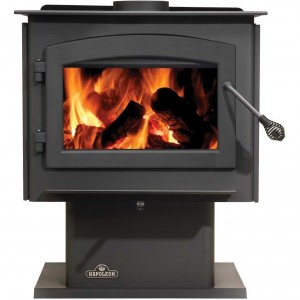
Steel Wood Burning Stoves
Steel wood burning stoves are very popular in small and mid-sized homes. They have taken the wood burning stove industry by storm owing to their airtight build, greatly improved efficiency and superior strength. These stoves consume less wood yet produce a lot of heat, making them highly efficient and an improvement even on the cast iron stove. Steel wood burning stoves have the entire range of quality and price ($1600-$2400) well covered. These stoves are very strong and durable. Steel is one of the strongest materials, and its use in stoves gives an excellent result. Vogelzang TR001 Defender EPA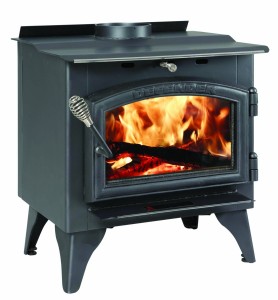
Soapstone Wood Stoves
Soapstone wood burning stoves are popular due to their capacity to store heat. These are the best stoves when it comes to heat storage. Although they take a longer time to heat up, they provide a steady, even and consistent heat flow. As a trademark, the heat continues to flow for a long time even after the fire has gone out. Soapstone is unique for its veins of color, which come in handy in the designing of beautiful wood burning stoves. Many wood stove reviews praise the beauty of soapstone stoves. Soapstone wood stoves offer efficiency, elegance, and timeless technology. Unlike the traditional fireplaces, which may be limited to blistering short-lived convection heat in close proximity, these stoves release heat slowly. When using the stove, the heat will feel like the warmth from afternoon sunshine. In addition to being beautiful and comfortable, soapstone wood burning stoves are very efficient. The stoves use contra flow technology. This means that the combustion gases used flow through channels within the stove. The gases are then released through the chimney. This flow allows the stove’s thermal mass to absorb and radiate heat slowly. This continues over a long period of time. This is a unique feature that improves the stove’s efficiency, making it one of the best stoves. When thinking about regulations, soapstone wood burning stoves are exempt from EPA rules and regulations. These stoves have been categorized by EPA among the stoves that are clean-burning. This can be attributed to the stove’s air-rich characteristics and high burn rates.
Factors To Consider When Buying A Wood Burning Stove
Getting the right information before making a purchase is very important. This can save you a lot of money, direct lenders for installment loans for people with bad credit also ensure that you are getting the best quality stove for your home. Here are some factors that we at BestStoves.net would advise you to consider when making a purchase.
Combustion Technology
Combustion in wood burning stoves is very important. You need to be sure that you know the technology used in the stove that you are buying. The debate about catalytic and non-catalytic combustion has endured for many years. Both processes have proved to be effective. but it is the performance differences that keep the debate going. With catalytic combustion, smoky gases are passed through ceramic honeycomb, which is coated with a catalyst. The honeycomb is buried inside the stove. Catalytic stoves come with a lever-operated catalyst bypass damper. This makes the stoves a little complicated. Many have argued that it takes time to open the damper when loading and starting the stove. Determining when to add the catalyst also makes the process lengthy and cumbersome. This is not to mention that the catalytic element needs to be replaced after some time. Non-catalytic wood burning stoves are a bit different. They do not use a catalyst. Instead, they create a good combustion environment. This is done by three features: firebox insulation, introduction of pre-heated combustion air and the baffle that diverts gas flow. The non-catalytic stoves give a more energetic heat output curve. However, their users take pride on the arrestingly beautiful heat they produce. These stoves aren’t very complicated to use and maintain. The only maintenance needed is the replacement of the baffle and some internal parts. For efficient combustion, the temperatures need to be very high, and can cause the internal parts to deteriorate. Now the question stands, which are the best stoves, catalytic or non-catalytic? A look at the latest studies shows that the market is slowly shifting in favor of non-catalytic stoves. A good number of mainstream wood stove manufacturers have now focused their attention on non-catalytic stoves. Contrarily, many manufacturers still stick to catalytic stoves. Both types of stoves have their benefits and shortfalls. With both burning with 90% efficiency, it is wise to compare research and determine the best stove for your home.
Emissions
The EPA established a smoke emission limit that was mandatory for catalytic stoves in 1980’s. These stoves were set at a limit of 4.1 grams of smoke in a single hour. Non-catalytic stoves, on the other hand, were allowed to produce up to 7.5 grams per hour. This difference shows that catalyst stoves work very well when new. Once the stove is put to its use, the catalytic element degrades, giving emissions that are higher than 7.5 grams per hour. Non-catalytic stoves do not degrade as much. Today, all wood stoves in the market have to meet the set standards. The stoves are certified for emissions in the range of 1-4 grams per hour. The EPA certified emission rate is the reliable number that one can use to compare stoves when searching for a good wood stove.
Efficiency
The higher the stove’s efficiency, the better it will serve you. On average, wood stoves give about one-third more efficiency than the conventional box, step stove or pot belly. This means that the costs of wood will be sliced by a third. Although the higher efficiency can be said to be a by-product of mandatory regulations such as the emission limits, it has made EPA rules win not only for the environment, but also for stove users. Pleasant Hearth 2200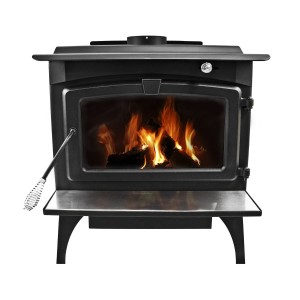
Heat Output
As you will see in our wood stove reviews, heat output is presented in British thermal units. For the popular brands, the heat output ranges between 25,000 and 80,000 BTU range. Our verdict is that this figure is misleading. First and foremost, the output of a wood burning stove shouldn’t be relied upon. This is because the continuous high firing can easily do serious internal damage to the wood burning stove. Secondly, the average house only needs 5,000 to 20,000 BTUs per hour, even in cold seasons. The output ranges given by the manufacturers differ. While some give the heat output from EPA, given by softwood fuel, some give their independent results using hardwood fuels. Another reason why heat output ranges may be misleading is that non-catalytic wood burning stoves tend to give out a higher peak heat output. This, however, doesn’t mean that these stoves will produce a higher amount of heat over a duration of eight hours. These ratings are not standardized, making it hard to compare different stoves. If you need to use the heat output rating, always go for the ratings from EPA. Drolet-High-Efficiency-Wood-Stove
Different sizes
To be sure that you are getting the best from your wood burning stove, consider all the variables. Wood stoves come in three sizes: large, medium and small. The shape of the stove’s firebox may affect its usable volume and that can result in exceptions in the guidelines we provide below.
- Large stoves. These have a firebox volume exceeding 3 cubic feet. They are suitable for large open plan and leakier plans.
- Medium stoves. The firebox volume ranges between 2 and 3 cubic feet. These are best fitted for small to medium houses.
- Small stoves. Their firebox volumes rarely go beyond 2 cubic feet. These are small stoves suitable for a large room or a seasonal cabin, as opposed to an entire home.
Burn Time
The duration taken to burn a single load of wood is also an important consideration. The burn time of a wood stove depends on the technology used in designing the stove. Modern stoves such as the US Stove 2000 provide about 10 hours of heat before the fire goes out. Normally, the stoves will last between 8 and 10 hours and getting the stove that gives 10 hours would be a great deal. Other factors discussed in our wood burning stove reviews, such as the wood species, moisture content and the heat needed, may also make a huge difference. Our experience is that medium and large wood burning stoves will give a reliable burn overnight and have enough coal to rekindle the fire in the morning. Small stoves may not give an overnight burn.
Log Length
Not every stove will handle 20 inch firewood, as some wood stove reviews tend to suggest. The standard wood length is 16 inches and is the most practical length for any stove. It is convenient to load and leave the recommended burning space. We recommend that log size should be 3 inches smaller than the firebox. This determines how efficiently the stove will perform.
Firebox Orientation
This is a factor that is not discussed in most wood stove reviews. The way your logs are oriented in the stove will always affect how they burn and the amount of heat the stove gives. You need to be careful about the orientation when choosing the best wood burning stove. The design of the stove will determine the log’s orientation. A wood burning stove with an east-west orientation come with a firebox that is wider than it is deep. This means that when looking through the glass door, you would be able to see the sides of the wood logs. This orientation means that not all of the firebox can be used, since loading the firebox to its full capacity could allow logs to fall against the glass door. This is not advisable. On the other hand, a wood burning stove with a north-south orientation comes with a firebox that is deeper than it is wide. This therefore means that when looking the glass door you would see the ends of your wood logs. When using a stove with a north-south orientation, you can load the firebox to its full capacity. This is because the wood cannot fall forward, even after burning. As a result, you will get more heating capacity than you would if using a stove with an east-west orientation.












